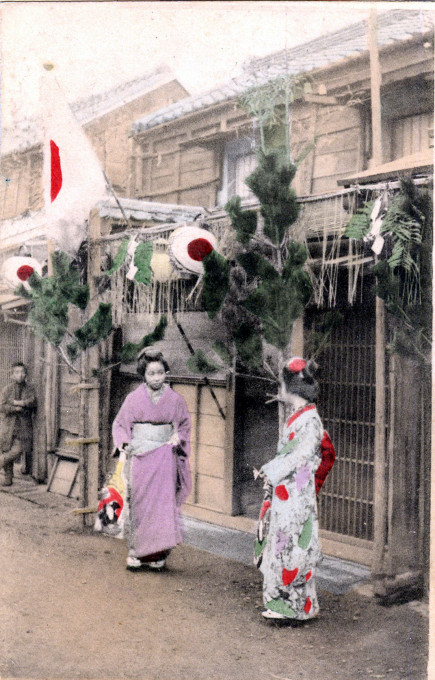
Onnanoko and New Year’s pine trimmings [kadomatsu], c. 1910, placed auspiciously at the entrance to their home.
See also:
Ebisu, God of Good Fortune, New Year’s postcard, c. 1920.
Hanetsuki (Japanese Badminton), New Year’s cards, 1910 & 1939.
Dezome-shiki (“First event”), New Year’s Day, c. 1910 & 1960.
“The Japanese return to their homes at New Year’s and, if at all possible, in summer for the Festival of the Dead (obon). In Japan, there is a great importance attached to the place of one’s birth (furusato or kokyo) and holiday visits reaffirm ties to ancestors, family, and community. A part of this holiday is devoted to welcoming kami. Several bamboo items are particular to New Year’s and are a part of creating a welcoming environment for these important protective spirits.
“The most significant are the ‘guardians of the gate’, or ‘pine guardians’ (kodomatsu), which appear outside doorways throughout Japan shortly before New Year’s, inviting deities to reside within during the holiday season. These symbolic constructions are made frequently with the tops of three vertical poles of bamboo cut at sharp angles (some suggest these points are to impale evil spirits). The poles are surrounded by pine boughs and sometimes decorated with auspicious symbols, such as lobsters, daidai oranges, and ferns.
“Pine and bamboo are appropriate symbols for the new year: pine, its role borrowed from China, has a long association with constancy and longevity. Green all year round, it is strong and rugged, and its sharp needles are said to scare away evil.”
– Bamboo in Japan, Nancy Moore Bess, 2001


Pingback: "Year of the Dog", New Year's Card, 1910. | Old Tokyo
Pingback: Pine tree at Karasaki, Omi, c. 1910. | Old Tokyo
Pingback: Christmas Card, Japan, c. 1920. | Old Tokyo
Pingback: Hanetsuki (Japanese Badminton), New Years cards, 1910 & 1939. | Old Tokyo
Pingback: “Buying New Year decorations”, c .1920. | Old TokyoOld Tokyo